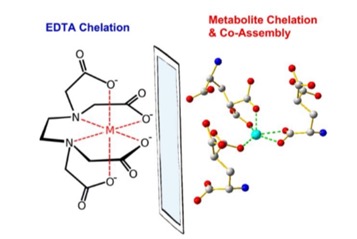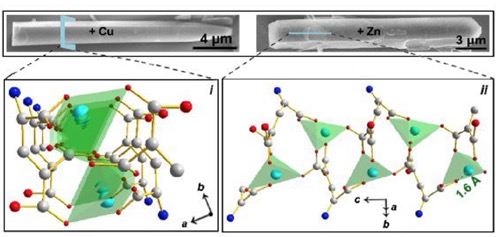Have you ever thought whether there is a substance in the world that can act as both a catalyst and a “power generator” and can be prepared on a large scale and highly energy-efficient.
Yes, there really is! Its name is: biological small molecule complexing agent. Through the R & D of γ-carboxyglutamic acid (Gla) as a biological small molecule complexing agent, Tao Kai, a young PI from Future Science Research Institute of ZJU-Hangzhou Global Scientific and Technological Innovation Center, and his team realized the performance of complexation effect comparable to that of traditional ethylenediaminetetraacetic acid ( EDTA) complexing agent, showing excellent catalytic performance and piezoelectric properties!
An Innovative Catalyzer
Researcher Tao Kai said that traditional biocatalysis is made possible with biological enzymes, but biological enzymes demand good storage conditions, and it is difficult to prepare biological enzymes on a large scale, and to synthesize artificially. Most of them can only be extracted from living organisms.
However, the biological small molecule complexing agent developed by Tao Kai and his team under the new framework is featured by low cost, simple preparation, and better catalytic performance than traditional biological enzymes.
The schematic diagram of the preparation of EDTA-like complex structures by Gla complex metal ions is shown in Figure 1. Similar to traditional EDTA, Gla participates in metal coordination with the carboxyl group on the molecular backbone so as to form a clamp-type chelating superstructural system.

Fig.1 Constitutive model of Gla-metal ion complexation
Further studies show the Gla-metal ion complex system can be self-assembled to needle-like crystal structures (Fig. 2). In the assembly, each metal ion and five carboxyl groups of three Glas form complex bonds, thereby a superstructural system with high thermal stability is assembled.

Fig. 2 Mechanism analysis of Gla-metal ion complex assembly
As copper ions [Cu (II)] play an important catalytic role in the metabolism of living organisms, the research team studied the catalytic performance of Gla+Cu (II) complex system at first and later it was found that Gla+Cu (II) had extremely high catalytic performance on the coupling reaction of 2,4-dichlorophenol (2,4-DP) and 4-aminoantipyrine (4-AP) (Fig. 3). In the presence of Gla+Cu (II) system, the reaction solution reaches an obvious absorption peak at 507 nm, which proves that Gla+Cu (II) shows excellent catalytic performance, so it is expected to replace traditional biological enzyme catalysts.

Figure 3. Catalytic performance test of Gla+Cu (II) complex superstructure.
Magic “Power Generator”
The piezoelectric performance, in some sense, can be understood as the capacity to generate mechanical power.
Tao Kai and his team discovered that designing and manufacturing a piezoelectric generator with the Gla+Zn (II) complex system as a pressure-sensitive component, under the action of an applied pressure of 50N, an open-circuit voltage (Voc) of 1.5 ± 0.3 V and a short-circuit current ( Isc) up to a signal output of 138.8 ± 26.5 nA can be realized, and it is equivalent to the power of an AA dry battery.
Meanwhile, this structure is also particularly “strong” and can withstand “thousands of trials”. The high mechanical strength of the complex architecture ensures that the piezoelectric generator has high tolerance and can maintain a stable voltage output after 1000 50 N pressure cycling tests (Figure 4).

Fig. 4. Piezoelectric generator fabricated by Gla+Zn (II) complex framework.
(a) Gla+Zn (II), a pressure-sensitive component in the piezoelectric generator;
(b,c) the relationship between device open-circuit voltage (Voc) and short-circuit current (Isc) and load; (d) Piezoelectric generator durability test.
There are bright prospects to design and manufacture piezoelectric generators with the Gla+Zn (II) complex system as a pressure-sensitive component because of its excellent piezoelectric properties.
Is it wonderful that lead-containing inorganic piezoelectric materials are no longer needed in batteries if this kind of piezoelectric generators is used to make biological batteries? As long as there is some pressure from the outside, biological batteries can generate power, which will be more environment-friendly than traditional batteries, so new horizons can be opened up to help realize carbon neutrality.
Meanwhile, this generator can also be applied to sensors. With the use of polypeptide biomaterials, it will be more suitable to be implanted into human body than other materials, so it will play a bigger role in wearable medical equipment to help the R & D of bionic electronic skin and the interactive equipment of bio-device interfaces.
Be innovative and pioneer the future
“Almost no research project will develop exactly as what we expect. Only by seizing some extraordinary moments can breakthroughs be achieved.” Tao Kai firmly believes that innovations can be achieved with breakthroughs, and innovations often originate from unexpectedness.
The discovery of biological small molecule complexing agents achieved unexpected results just because Tao Kai and his team used amino acids to design an EDTA-like clamp-type complexing architecture system, and combined amino acids and metal ions in an innovative way.
The complex architecture can be self-assembled to needle-like superstructures so as to significantly boost the activities of complexing metal ions and show excellent catalytic and piezoelectric properties; therefore, it can provide a new way of thinking for the design and manufacturing of multifunctional bio-organic soft devices with bio-organic small molecule complexing superstructures.












